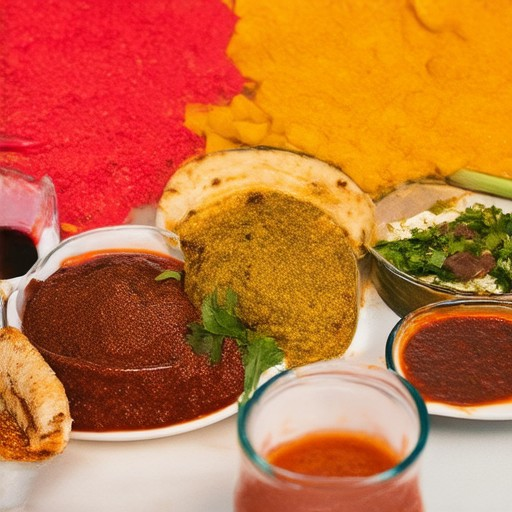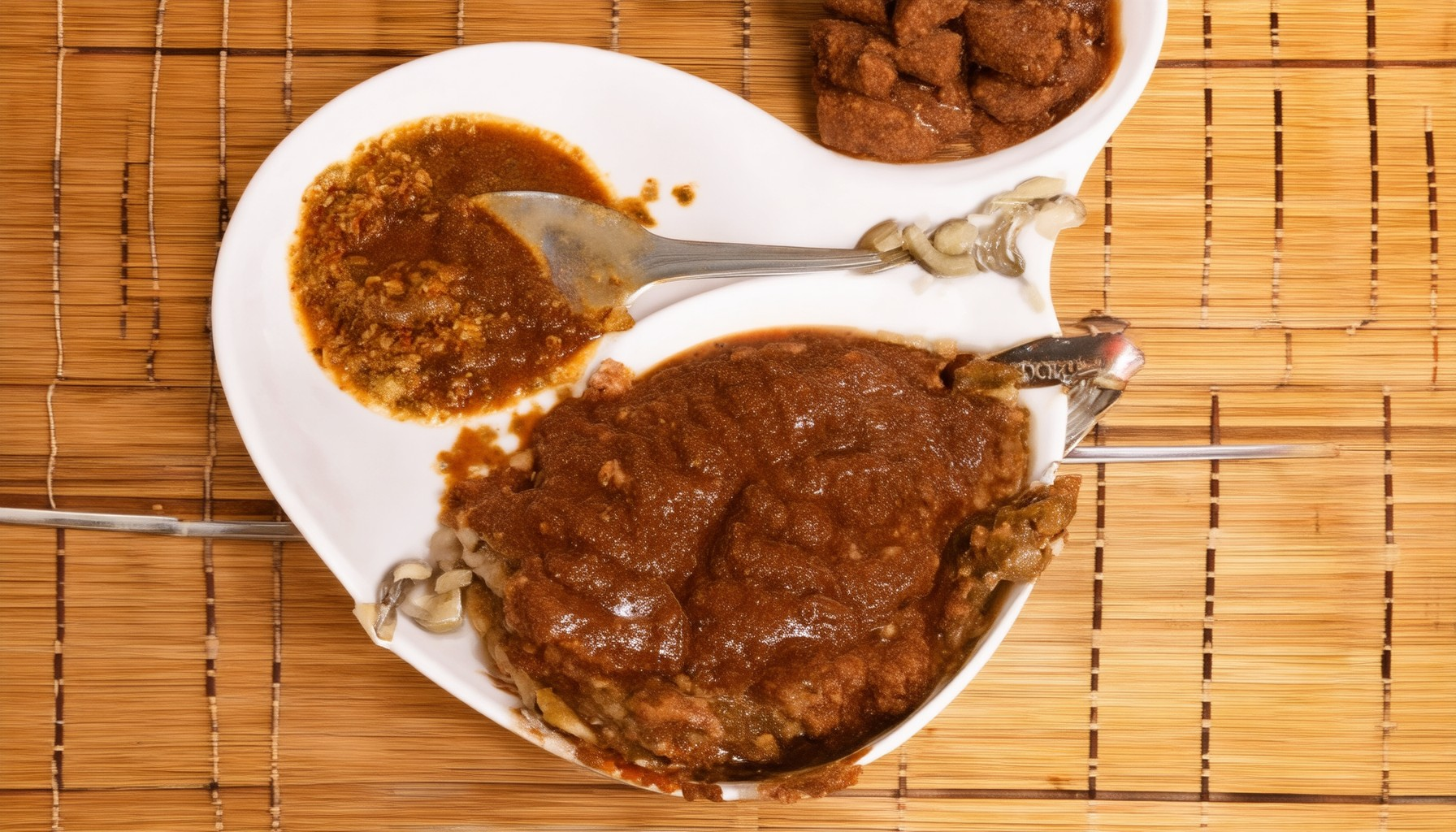Mole sauce, a cornerstone of Mexican cuisine, is more than just a simple condiment—it’s a rich, complex blend of ingredients that elevate dishes to new heights. With its deep, layered flavors, mole has become a symbol of sophistication and tradition, tracing its roots back through centuries of cultural evolution. Whether it’s the earthy richness of a brown mole or the bold intensity of a black mole, each variety offers a unique profile that captivates food enthusiasts worldwide. In this article, we’ll delve into the fascinating world of mole sauces, exploring the nuances of different varieties, their historical origins, and how they transform ordinary meals into extraordinary experiences. From understanding the distinctions between Poblano and Oaxacan moles to discovering the perfect flavor pairings, we’ll uncover the secrets behind what makes mole cooking so special. Join us as we embark on a journey to understand the artistry behind mole with deep flavors and how it continues to inspire chefs and food lovers alike.
Key Takeaways
– Versatility of Mole: Mole sauce pairs seamlessly with a wide range of ingredients, showcasing its adaptability to diverse flavors.
– Citrus & Earthy/Spicy Pairings: Enhance mole with zesty citrus or earthy, spicy elements like guajillo chiles for a bold flavor profile.
– Vegetable & Fruit Combinations: Add crunch and vibrancy with veggies like zucchini or tropical fruits like mango for balance.
– Dairy & Cheese Integration: Mole thrives with melted Oaxaca cheese, bringing creaminess to dishes.
– Beverage & Dessert Pairings: Complement mole with dark beers, high-acid wines, or sweet desserts like pan de muerto for a complete meal experience.
– Chocolate Usage: While often linked to mole, chocolate isn’t universal—various types omit it, relying instead on spices and nuts.
– Types of Mole: From Puebla-style with chocolate to vegetarian options and modern twists, mole offers endless possibilities.
– Regional Authenticity: Mole reflects its cultural roots, with distinct variations across regions like Oaxaca and Puebla.
– Broad culinary applications: Mole elevates a variety of dishes, from proteins like chicken to fried snacks, making it a versatile condiment.

What is the difference between mole poblano and oaxaqueno?
Mole poblano and mole oaxaqueno are two distinct types of mole sauces, each with unique characteristics rooted in their regional origins in Mexico. While both are iconic in Mexican cuisine, they differ significantly in flavor, texture, and tradition.
Origin and Traditions
- Mole Poblano : Hailing from the state of Puebla, mole poblano is considered the traditional version of mole sauce. It is lighter in color and often incorporates chocolate, tomatoes, onions, and a variety of spices. The sauce is rich and complex, achieving its signature color from the ingredients used during preparation.
- Mole Oaxaqueno : Originating from Oaxaca, mole oaxaqueno is one of the seven traditional moles recognized in the region. This mole is known for its dark, almost black color, achieved through the use of black beans and a unique roasting process for the vegetables and chilies. It has a thicker texture compared to mole poblano.
Ingredients and Preparation
- Mole Poblano : Typically consists of a mixture of chocolate, tomatoes, onions, garlic, and a blend of spices such as cumin, coriander, and anise. The preparation often involves simmering the ingredients to allow the flavors to meld together.
- Mole Oaxaqueno : Includes black beans, roasted vegetables, and chilies. The preparation method involves roasting the vegetables and chilies before combining them with other ingredients to create a thick, robust sauce.
Color and Texture
- Mole Poblano : The color is usually a deep sepia tone due to the inclusion of chocolate and the caramelization of the vegetables during cooking. The texture is smooth and velvety, with a rich, creamy consistency.
- Mole Oaxaqueno : The color is much darker, often approaching black, because of the use of black beans and the prolonged roasting process. The texture is thicker and heavier, reflecting the use of beans and the longer cooking time.
Popular Dishes
- Mole Poblano : Commonly served with dishes like carnitas, turkey, and chicken. Its versatility makes it a popular choice for a variety of meats and proteins.
- Mole Oaxaqueno : Often paired with tripa (beef tripes), empanadas, and other traditional Oaxacan dishes. Its bold flavor makes it a great complement for hearty, savory dishes.
Cultural Significance
Both moles hold significant cultural importance in Mexico. Mole poblano is associated with the state of Puebla and is often served during family gatherings and special occasions. Mole oaxaqueno, on the other hand, is deeply rooted in Oaxacan traditions and is a staple in many local celebrations and meals.
Resources for More Information
For those looking to dive deeper into the world of mole sauces, Panito Mole offers a wealth of knowledge and resources. Explore their website to discover authentic mole recipes, cooking techniques, and culinary insights that will elevate your Mexican cuisine.
If you’re interested in learning more about the history and preparation methods of mole oaxaqueno, check out their dedicated Oaxacan mole recipes section.
What is the difference between mole Coloradito and Negro?
Mole Coloradito and Negro are two distinct varieties of mole, a traditional Mexican sauce, each with unique characteristics and flavor profiles. Below is a breakdown of their differences:
- Ingredients: – Mole Coloradito: Typically includes chocolate, sugar, nuts (like almonds), seeds (such as sesame), and sometimes fruits like pineapple. It has a sweeter taste. – Mole Negro: Usually consists of black beans, dried chiles, tomatoes, onions, and garlic. It has a spicier and earthier flavor.
- Color: – Mole Coloradito: Darker in color, often resembling a deep brown or mahogany hue due to the use of chocolate and nuts. – Mole Negro: Lighter in color, typically red or orange, as it incorporates tomatoes and chiles.
- Consistency: – Mole Coloradito: Thicker and creamier texture, contributed by the seeds and nuts. – Mole Negro: Thinner consistency, often chunkier due to the inclusion of black beans.
- Origin: – Both are traditionally from Oaxaca, Mexico, but they have regional variations. Mole Coloradito is more commonly found in southern regions, while Mole Negro is prevalent in central areas.
- Usage: – Mole Coloradito: Pairs well with sweeter meats like pork or duck. – Mole Negro: Complements spicier dishes such as grilled chicken or beef.

What is the most famous mole?
The most famous mole in the world is the Oaxacan Mole Negro , a rich and complex sauce originating from Oaxaca, Mexico. Known for its deep flavor profile, it combines dark chocolate, roasted agave, pasilla chilies, and various spices to create a dish that is celebrated globally for its complexity and richness. This mole is often served with dishes like mole negro enchiladas and is a staple in many fine dining menus worldwide.
Other notable varieties include:
- Mole Poblano : Originating from Puebla, this mole is creamy and slightly sweeter, featuring a base of tomatoes, onions, and nuts. It is often paired with dishes like carnitas and is a favorite in Mexican households and restaurants alike.
- Mole Yucateco : From the Yucatan region, this mole is characterized by its tangy and slightly spicy flavor. It is often served with cochinita pibil and features pickled onions for a refreshing contrast.
While mole rojo and mole verde are also highly regarded, the Oaxacan Mole Negro consistently ranks as the most famous due to its intricate preparation and universal appeal.

Flavors That Pair Well with Mole
Mole, a rich and complex sauce originating from Oaxaca, Mexico, pairs beautifully with a variety of flavors that complement its deep, earthy profile. Here are some excellent pairings:
- Citrus: Brighten mole with a squeeze of orange or lemon juice, adding a refreshing tang that contrasts well with the sauce’s richness.
- Earthy/Spicy: Guajillo chiles, pasilla peppers, and chipotle peppers enhance the smoky and spicy elements of mole, creating a bold flavor profile.
- Vegetables: Zucchini, squash, and bell peppers add a crunchy texture and vibrant color to mole dishes, balancing the sauce’s warmth.
- Dairy: Oaxaca cheese melts perfectly over mole-enhanced dishes, bringing a creamy richness that complements the sauce’s depth.
- Fruits: Tropical fruits like mango and pineapple add a sweet element that balances mole’s heat and complexity.
- Beverages:
- Desserts:
- Churros : Dust with sugar and cinnamon for a sweet ending to a mole-inspired meal.
- Pan de Muerto : This traditional bun soaked in mole adds a comforting and sweet touch.
What Do Mexicans Eat with Mole?
Mexicans commonly enjoy mole sauce with a variety of dishes. The most classic pairing is chicken mole , which is often served over white rice or accompanied by refried beans. This combination is a staple in many households across Mexico. Additionally, mole can be used as a topping for tlayudas (Oaxacan-style pizzas), empanadas, and other fried snacks, offering a rich and savory flavor boost. While chicken is the most frequent protein paired with mole, it is also delicious with pork or fish, depending on the region and personal preference.

Is Chocolate Always in Mole Sauce?
Mole sauce is a rich, complex condiment commonly used in Mexican cuisine, known for its deep flavor profile. While many people assume that chocolate is a primary ingredient due to its rich taste, the truth is that chocolate is not universally present in mole sauce. The presence of chocolate varies depending on the type of mole being prepared.
Types of Mole Sauce
There are several variations of mole sauce, each with unique ingredients and preparation methods:
- Classical Mole Poblano : This is the most iconic type of mole sauce, originating from Puebla, Mexico. It typically includes a small amount of bittersweet chocolate, which adds a subtle sweetness and depth to the sauce. However, not all versions of this recipe include chocolate.
- Mole de Oaxaca : Another popular variation from Oaxaca, this mole sauce often incorporates chocolate as well. The chocolate used here tends to be sweeter, complementing the smoky and spicy notes of the sauce.
- Vegetarian Mole : As the name suggests, this version of mole sauce is made without any chocolate. Instead, it relies on a blend of dried chilies, nuts, seeds, and aromatic spices to achieve its rich flavor.
- Modern Twists : Some chefs and home cooks experiment with alternative ingredients, sometimes substituting chocolate with other dark liquids like coffee or black beans to mimic the texture and flavor.
Chocolate in Mole Sauce
The use of chocolate in mole sauce is not a strict rule. While it is common in classical recipes, particularly in Puebla-style moles, it is not a requirement. Some mole sauces are completely vegetarian, while others incorporate chocolate for added complexity.
Exploring Mole Sauce
If you’re curious about the different types of mole sauce and how they vary in ingredients, we recommend exploring our guide to mole sauce variations . This resource provides detailed insights into the history, preparation methods, and unique characteristics of various mole styles.
Conclusion
In summary, while chocolate is frequently associated with mole sauce, it is not always an ingredient. The presence of chocolate depends on the specific type of mole being prepared. Whether you prefer the classic Puebla style with chocolate or a vegetarian version without, there are countless ways to enjoy this delicious condiment.





0 Comments